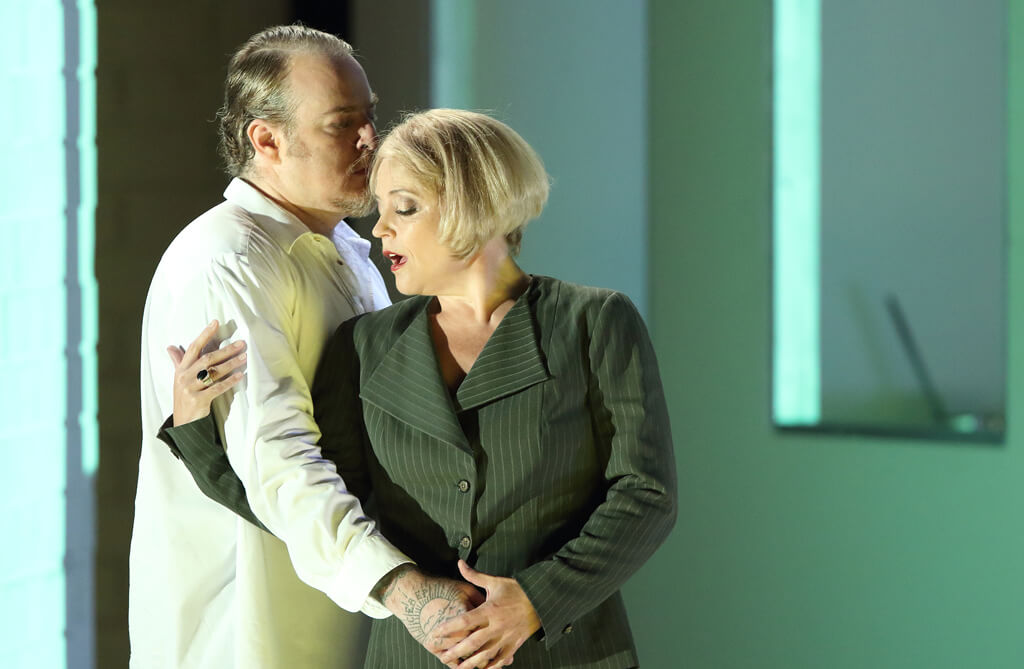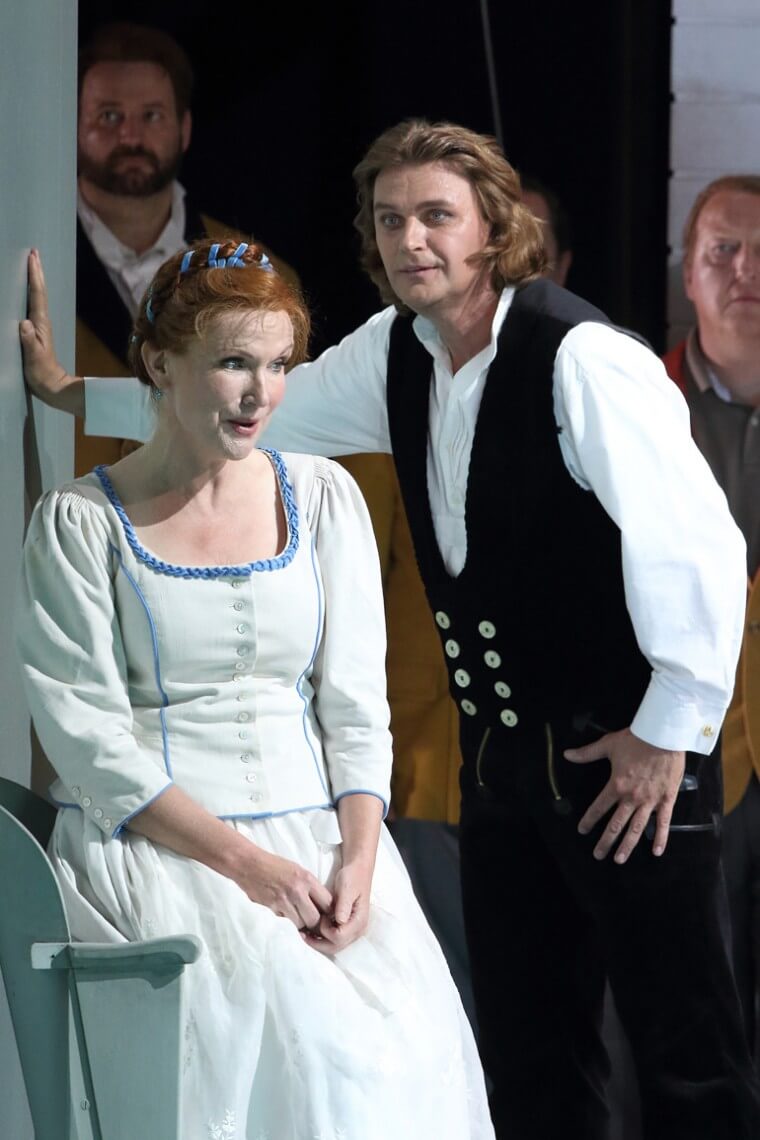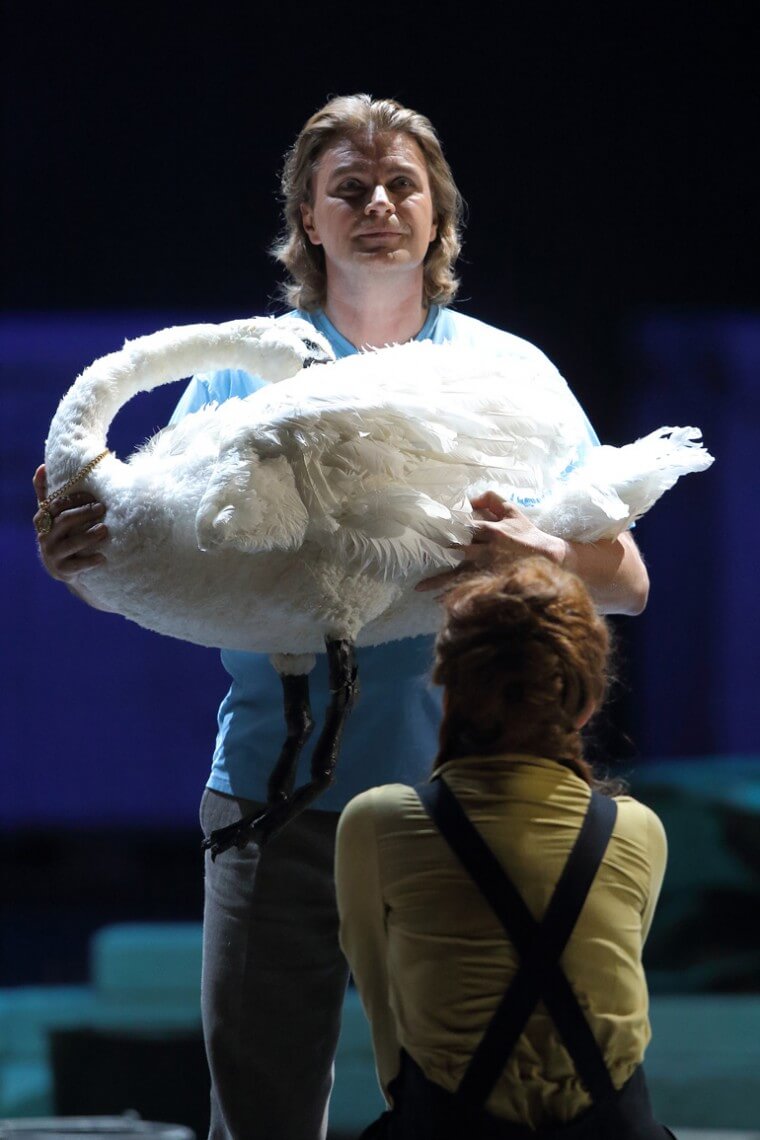
Klaus Florian Vogt (Lohengrin), Anne Schwanewilms (Elsa), Evelyn Herlitzius (Ortrud), Evgeny Nikitin (Telramund), Christof Fischesser (Heinrich), Markus Eiche (Heerrufer). Lothars Koenigs, conductor. National-theater, Bayerische Staatsoper, July 2, 2016.
MUNICH, GERMANY — Given I’m a diehard Wagnerite, any performance of Lohengrin is an occasion. One of Wagner’s earlier successes, this piece, unlike his later creations, still shows remnants of the Italian opera formal structure with well-defined overtures, arias, duets, ensembles, and choruses. And when one encounters a performance with singers and an orchestra the quality of last evening’s, it’s an unalloyed pleasure. I’ve heard all the principals previously either here in Munich, New York, or in the case of Evgeny Nikitin (Telramund), at the Canadian Opera Company. I was particularly looking forward to the Elsa of German soprano Anne Schwanewilms, who will be in Toronto in two weeks, to give masterclasses and to mentor the young artists of the Toronto Summer Music Art of the Song program.
Lengthy operas in European houses often mean a really early start, in this case, five in the afternoon! When I arrived on the steps of the National-theater, I saw lots of people holding up pieces of paper, not the usual “suche karte” but to actually sell tickets! Well, it turned out the lure of Germany playing Italy in football was too great and some decided to forgo the pleasure of Lohengrin for a little time in front of the television…
Well, they have missed a great performance! German tenor Klaus Florian Vogt is the Lohengrin of one’s dream — handsome and youthful of face and slim of carriage, a voice of clear and sweet timbre, capable of the most honeyed of pianissimi, yet with amazing power. I was stunned by his volume, which I hadn’t suspected, but no matter how loud, it’s never harsh. His soft singing in “In fernem Land” was just outstanding, and when the power is called for, he delivers. I had a great seat, 9th row in the middle. I can only imagine how glorious he sounds in the upper reaches of the 2000 seat National-theater, a theatre where our Four Seasons Centre is modelled after. For about 10 years in the 80’s and 90’s, Canadian Heldentenor Paul Frey was the definitive Lohengrin – pace Peter Hofmann! Frey sang something like 27 performances of the swan knight at Bayreuth, which I understand is still a record. Vogt is his worthy successor.

Vogt was well matched by German soprano Anne Schwanewilms as a very lyrical, soft-grained Elsa, in the tradition of the great Elisabeth Grummer as opposed to the dramatic heavyweights like Eva Marton. Her timbre is soft but with enough thrust to be heard over the orchestra, given the compact size of her soprano. Only in the climactic high B’s of the Bridal Chamber Scene did she sound a bit stretched. Schwanewilms is also a most sympathetic Elsa, her remorse in Act 3 deeply moving.
The “Bad News Couple” was ably taken by German soprano Evelyn Herlitzius and Russian baritone Evgeny Nikitin. Herlitzius’ Elektra brought tears to my eyes in Berlin two months earlier, but she plays evil equally well – her Ortrud is currently unsurpassed. In this production, she was on stage all of Act one, silently observing, except for just a line or two at the end. Act 2 belongs to Ortrud, and she was stunning, her Entweihte Götter was very powerful, given how small and slim Herlitzius is. In fact, she reminds me a lot of Dame Gwyneth Jones in being so petite yet with enormous vocal power. Her partner in crime was Russian bass-baritone Evgeny Nikitin, a very fine singer in his own right. He sang in Toronto at least twice. He matched the Ortrud well, and the two of them were highlights as well.

Elsewhere I was very impressed with the Munich fest artist Christof Fischesser whom I’ve heard many times in the past, as a wonderfully sonorous Heinrich. And I mustn’t forget Markus Eiche, the Golaud of last summer’s Pelleas et Melisande. His Heerrufer tonight was the most gorgeous I’ve heard. Together with Vogt, top vocal honours had to go to the magnificent chorus. In acts 2 and 3, their singing of the absolutely divine choral writing by Wagner brought a lump to my throat. The conducting by Lothar Koenigs, an excellent maestro, was totally idiomatic – vital, well judged, lyrical. I would walk the extra mile to hear him conduct again.
Now, my comments about the Richard Jones production. I saw this new six years ago, and I have to say I hated it at the time. The ‘concept’ has a lot to do with Germanic nationalism (okay, with a small ‘n’) given the surfeit of symbolism. The set, the costumes, the uniforms, the stage direction all harken back to German society in the 1930’s, an unfortunate moment in their history. Although I cannot explain why there was a modern video camera capturing the wedding ceremony! The way Act One is staged with the Heerrufer’s decree and the uniforms, the mass suicide of the towns people at the end of the opera… Given today’s European political climate, this production likely gives some people in the audience an uncomfortable feeling in the stomach. The people around me sat on their hands when the final curtain came down — although no boos, unlike six years ago. These same folks wildly applauded the singers later. I think I got the message.
The centrepiece of the production is the building of the new house of Lohengrin and Elsa, a theme that runs through the whole opera. When the bridal night takes a turn for the worse, Lohengrin takes gasoline and set fire to the baby crib and the bed! It was a bit shocking, although the staging has been modified somewhat. Some friends remind me that six years ago, the Lohengrin (then it was Kaufmann) was wrecking the place, throwing the furniture around. Also, I can’t help observing the building the house, with no foundation. Well, you know what they say about a house with no foundation! No wonder the marriage of Lohengrin and Elsa is doomed! For me, the excellent musical values of this performance was what I came for, and I got it in spades, never mind the production. The ovations at the end went on for at least 20 to 25 minutes. One thing I love about Munich and other German houses – even if a couple of dozen people stayed behind to applaud out of 2000, the artists come out again for more bows. Once again, Bravi tutti!
Read Letters From Munich Part I (Tosca), here , and Part III (La bohème), here.
#LUDWIGVAN
Want more updates on Toronto-centric classical music news and review before anyone else finds out? Get our exclusive newsletter here and follow us on Facebook for all the latest.
- SCRUTINY | Opera Atelier’s All Is Love Makes Triumphal Return - April 15, 2024
- SCRUTINY | From The Heart: Ema Nikolovska And Charles Richard-Hamelin Offer Unique Program At Koerner Hall - March 26, 2024
- SCRUTINY | The Glenn Gould School Spring Opera Presents A Superb Dialogues Des Carmélites - March 22, 2024



